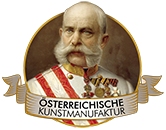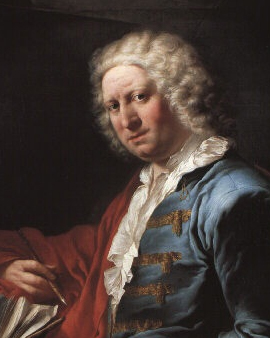Giovanni Paolo Pannini was especially known for his large-scale cityscapes and vistas, also known as veduta. He was particularly interested in the city of Rome, which served as his home for most of his life. His works showed both real and imaginary views of the ruins of ancient Rome. Pannini combined precise observation and tender nostalgia in his works. In this way, he incorporated elements of both the late classical baroque and early romanticism in his paintings. Among his best-known works are various depictions of the Pantheon and St. Peter's Basilica, in which he repeatedly varied smaller details in the composition, thus providing variety.
In Italy it was customary for famous painters to be addressed only by their last name. This was also true for Pannini. His training began in his hometown of Piacenza, in the Duchy of Parma. He studied with Guiseppe Natali, Andrea Galluzzi and Francesco Galli Bibiena, among others. From Galli Bibiena he learned the profession of stage designer. How long his training lasted in Piacenza and at what age he began to devote himself to art is not exactly known. From 1711 Pannini finally moved to Rome. There he received drawing lessons from Benedetto Luti. During his time in Rome he also made the acquaintance of Canaletto, whose works had a strong influence on Pannini. His training as a stage designer allowed him to artistically design various palaces in Rome, which quickly made him famous. In the years from 1719 to 1725 he worked as a decorator at Villa Patrizi, Palazzo de Carolis or Seminario Romano. Pannini was also allowed to paint some famous personalities of his time during his career, such as Pope Benedict XIV. He was also commissioned a few times to paint Roman festivals. Before 1730, however, Pannini's works were heavily influenced by historical and religious motifs.
Pannini was also very active as a teacher and influenced many young artists. He became a member at the Accademia di San Luca between 1718 and 1719. He later became a teacher there as well. The Académie de France accepted him as a member in 1732 and later hired him as a professor of perspective at their school in Rome. There he taught, among others, Jean Honore Fragonard, whom he is said to have influenced. Other students of his were his son Francesco Pannini, who later followed in his father's footsteps, the Frenchman Hubert Robert and the veduta painter Antonio Joli. Robert worked in Pannini's studio and is considered his most important student. Pannini's style also indirectly influenced vedutists such as Canaletto and Bernardo Bellotto. His particular eye for perspective was widely imitated. Pannini's second son Guiseppe also took up an artistically influenced profession and became a respected architect. Pannini died in Rome at the age of 74 and painted less and less often in his last years.
×





.jpg)
.jpg)
.jpg)
.jpg)
.jpg)
.jpg)
.jpg)
.jpg)
.jpg)
.jpg)
_-_(MeisterDrucke-1453505).jpg)
_-_(MeisterDrucke-1453505).jpg)
.jpg)
.jpg)
.jpg)
.jpg)
_-_(MeisterDrucke-1324450).jpg)
_-_(MeisterDrucke-1324450).jpg)
.jpg)
.jpg)
.jpg)
.jpg)
.jpg)
.jpg)
.jpg)
.jpg)
.jpg)
.jpg)
.jpg)
.jpg)
_(1716-_-_(MeisterDrucke-999831).jpg)
_(1716-_-_(MeisterDrucke-999831).jpg)
.jpg)
.jpg)
.jpg)
.jpg)
.jpg)
.jpg)
.jpg)
.jpg)
.jpg)
.jpg)
.jpg)
.jpg)
.jpg)
.jpg)
.jpg)
.jpg)
.jpg)
.jpg)
.jpg)
.jpg)
.jpg)
.jpg)
.jpg)
.jpg)
.jpg)
.jpg)
.jpg)
.jpg)
.jpg)
.jpg)
.jpg)
.jpg)
.jpg)
.jpg)
_(1690-1756)_cardinal_of_Clem_-_(MeisterDrucke-1001880).jpg)
_(1690-1756)_cardinal_of_Clem_-_(MeisterDrucke-1001880).jpg)
.jpg)
.jpg)
.jpg)
.jpg)
.jpg)
.jpg)
_Painting_Giovanni_Paolo_Pannini_(Pan_-_(MeisterDrucke-1002937).jpg)
_Painting_Giovanni_Paolo_Pannini_(Pan_-_(MeisterDrucke-1002937).jpg)
.jpg)
.jpg)
.jpg)
.jpg)
 Visiting St Peters in Rome 1730 - (MeisterDrucke-76549).jpg)
 Visiting St Peters in Rome 1730 - (MeisterDrucke-76549).jpg)
.jpg)
.jpg)
.jpg)
.jpg)
.jpg)
.jpg)
.jpg)
.jpg)
.jpg)
.jpg)
.jpg)
.jpg)
.jpg)
.jpg)
.jpg)
.jpg)
.jpg)
.jpg)
.jpg)
.jpg)
.jpg)
.jpg)
.jpg)
.jpg)
.jpg)
.jpg)
_painting_Palace_-_(MeisterDrucke-1103869).jpg)
_painting_Palace_-_(MeisterDrucke-1103869).jpg)
.jpg)
.jpg)
.jpg)
.jpg)
.jpg)
.jpg)
.jpg)
.jpg)
.jpg)
.jpg)
.jpg)
.jpg)
.jpg)
.jpg)
.jpg)
.jpg)
.jpg)
.jpg)
.jpg)
.jpg)
.jpg)
.jpg)
.jpg)
.jpg)
.jpg)
.jpg)
.jpg)
.jpg)
.jpg)
.jpg)
.jpg)
.jpg)
.jpg)
.jpg)
.jpg)
.jpg)
.jpg)
.jpg)
.jpg)
.jpg)
.jpg)
.jpg)
.jpg)
.jpg)
.jpg)
.jpg)
.jpg)
.jpg)
.jpg)
.jpg)
.jpg)
.jpg)
.jpg)
.jpg)
.jpg)
.jpg)
.jpg)
.jpg)
.jpg)
.jpg)
_-_(MeisterDrucke-898223).jpg)
_-_(MeisterDrucke-898223).jpg)
.jpg)
.jpg)
.jpg)
.jpg)
.jpg)
.jpg)
.jpg)
.jpg)
.jpg)
.jpg)
.jpg)
.jpg)
.jpg)
.jpg)
.jpg)
.jpg)
.jpg)
.jpg)
.jpg)
.jpg)
.jpg)
.jpg)
.jpg)
.jpg)
.jpg)
.jpg)
_-_(MeisterDrucke-1457765).jpg)
_-_(MeisterDrucke-1457765).jpg)






